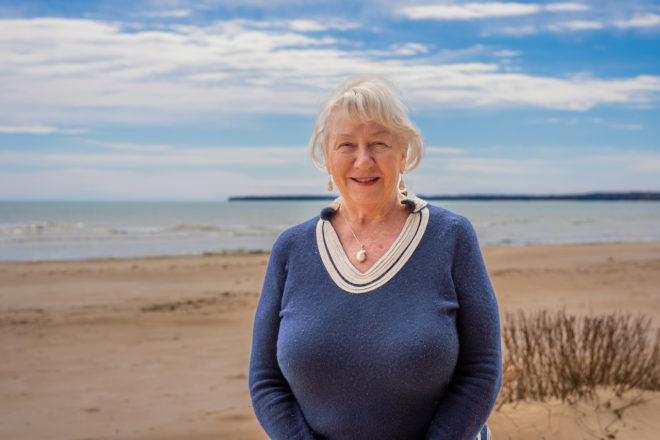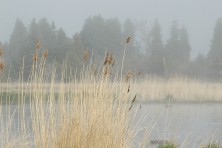The Phragmites Queen: Jo Whalen
- Share
- Tweet
- Pin
- Share

Grant-dependent conservation programs rely on volunteers to leverage finances and broaden their network and messaging.
Those who come up with a program and then run with it are considered “super volunteers” by Sam Koyen, the Door County Invasive Species Team (DCIST) coordinator for the County of Door Soil and Water Conservation Department (SWCD). The most super of them all when it comes to non-native phragmites control is Joleen “Jo” Whalen.
“She was – still is – the phragmites queen,” Koyen said. “Back in the day, she helped promote municipal ordinance change, coordinate local volunteer groups, and get permissions to control non-native phragmites.”
The SWCD bestowed its 2018 Volunteer of the Year award on Whalen for her “extraordinary service and dedication to our mission,” and she’s still very active. As Lake Michigan waters continue to recede from historically high levels, people should be on the lookout for new outbreaks.
“We’ll likely need [Whalen] again to help with these efforts,” Koyen said.
Phragmites Meets Its Match
Whalen said her conservation volunteer efforts are all about “taking care of what you can take care of.”
This care begins where her ancestors planted themselves five generations ago – the Campbells in Jacksonport, the Sloans in Baileys Harbor. Today, she and her sister have side-by-side ancestral properties along a Jacksonport shoreline where nine of their cousins also live.
Whalen, then, is planted far deeper in the local soil than a plant that hitchhiked from the Middle East within ballast or ship packaging and arrived in Door County during the late 1990s. So when she turned her part-time Door County life into a full-time residency in 2003 and saw that the perennial grass had conquered the shoreline, she decided to act.
Non-native phragmites – there is also a variety that’s native to Door County – is a perennial grass that can reach heights of 20 feet, spreading by rhizome and seed. It’s pointless to eradicate it on one property when neighboring properties also host the plant – and the infestation was visible along the Jacksonport shoreline in both directions as far as the eye could see. Whalen said she knew that she and her neighbors would need to take collective action to vanquish the invader and rallied them to the cause.
“I went from house to house from Baileys Harbor to Cave Point to get people signed up,” she said.
Whalen persuaded an existing neighborhood association at the time to reinvent itself as the Shores of Jacksonport Neighborhood Association (SJNA) to “advance and protect the area” by representing a larger number of property owners who could provide a collective voice on local issues and complete projects “for the betterment of the neighborhood,” as SJNA’s current mission statement says. (Whalen remains active with the group and is listed as its vice president.)
“That really helped with a group behind the whole project,” she said.
After getting the property owners on board behind phragmites eradication, “the next step was to get the town [of Jacksonport] backing it,” Whalen said – which she did, enabling the passage of a noxious-weeds/invasive-species ordinance that made it easier to cost-share eradication funds with the county.
She partnered with the town and the County of Door by providing all-volunteer, beach-walking phragmites and invasive-species scouts to deliver data to the county to assist with its grant writing for invasive-species–control funding. That volunteer effort continues to this day.
“I have six walkers who walk from here [Jacksonport] to Cave Point once a year, and they do it at their leisure,” she said. “That’s worked just beautifully.”
But Whalen didn’t stop with her own town. Each year she’d ask the DCIST team what it needed and organize volunteers who could get it done. She also traveled from town to village across the peninsula – sometimes with DCIST, sometimes on her own – to talk with boards about the need for noxious-weed ordinances.
“It really helped the towns and villages,” she said. “And we couldn’t just talk about phragmites because there are too many invasives.”
Eleven municipalities in Door County adopted those ordinances, Koyen said, and it wouldn’t have happened without Whalen, either directly or indirectly.
“Mobilizing the right people is the key,” Whalen said. “They have to be willing and interested. I’m kind of good at connecting people and things. I pay attention to what else is going on.”
A Master Organizer
Whalen, 80, grew comfortable talking at town and village board meetings about invasive species and the need for official ordinances to help fund weed control. But she’s not a botanist, and neither does she pretend to be.
“The thing is, I’m not all that knowledgeable about invasive species,” she said. “I had Soil and Water [the conservation department] for that. They knew their part. My part was to organize the people. Knowing who to go to and where to get the help was a major thing. And that carries over to everything you do.”
These days, Whalen is using technology to grow her army of invasive-species scouts by spreading awareness about the ways in which property owners can self-report invasives, either through the Great Lakes Early Detection Network (GLEDN) app, or by contacting the SWCD (see the sidebars for details).
‘What Else Can I Do?’
Whalen always volunteered while living her pre–Door County life in Dodge County (she raised her children on a farm in Randolph, Wisconsin), largely in the arts. (She started an art museum in Beaver Dam, where she grew up.)
And in Door County, she has volunteered at the Miller Art Museum in Sturgeon Bay for a couple of decades, as well as for the Jacksonport Historical Society, the Jacksonport Women’s Club and other organizations.
“The question I always asked was, ‘What can I do to help?’” she said.
Whalen’s conservation volunteering comes from her philosophy that air, water, land, animals and plants are more important to this planet than humans. Given our relative unimportance, we should be good stewards of the earth’s most important resources, beginning with individual landowners.
“A lot of people think if they own something, they can do whatever they want, when really the land should dictate what you can do,” Whalen said. “If you live close to the water, you shouldn’t be able to do anything that impairs the water. That’s the philosophy I have about that.”
That philosophy has inspired her to “pull people and things together” over the years for invasives-species control, and for the beautification of Jacksonport through planting Prairie Fire crabapple trees, and for townwide water-quality testing, and for advocating that all property owners live on their land as it’s intended to be lived on.
And she’s not done yet.
“I must think I am still young, as I live thinking, ‘What else can I do?’” Whalen said.
Got Phragmites?

The County of Door has money to treat non-native phragmites on private property. Owners who are interested in this effort may contact Sam Koyen, the County of Door’s invasive-species coordinator, at 920.746.2363 or [email protected]; or go to doorinvasives.org and fill out the non-native phragmites permission slip.
Map Invasives with Your Phone
The Great Lakes Early Detection Network (GLEDN) is an online system that collects invasive-species reports from casual observers, verifies these reports and then integrates them with other networks. The Door County Invasive Species Team (DCIST) verifies and collects data using the GLEDN smartphone app, which is available at apps.bugwood.org/apps/gledn. DCIST is alerted of any invasive-species information recorded for Door County, and that information helps the local team to determine priority species, control projects and outreach needs.


